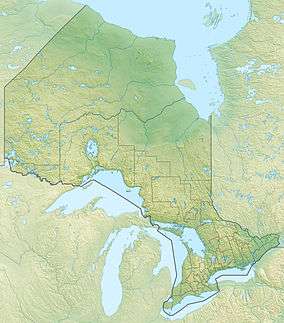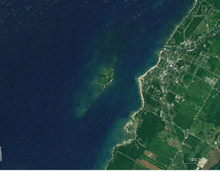Chantry Island Lightstation Tower
 Keepers Dwelling, Lighthouse and Shed | |
 Ontario | |
| Location | Lightstation, Chantry Island, Ontario |
|---|---|
| Coordinates | 44°29′22″N 81°24′07″W / 44.48938°N 81.40194°WCoordinates: 44°29′22″N 81°24′07″W / 44.48938°N 81.40194°W |
| Year first constructed | 1859 |
| Automated | 1954 |
| Construction | limestone tower |
| Tower shape | cylindrical tower with balcony and lantern |
| Markings / pattern | white tower, red lantern |
| Height | 26 metres (85 ft) |
| Focal height | 31 metres (102 ft) |
| Original lens | Fresnel lens |
| Current lens | Solar |
| Range | 6 nm |
| Characteristic | Fl W 4s. |
| CHS number | CCG-788 |
| ARLHS number | CAN-619 |
| Managing agent |
Canadian Wildlife Service (Ontario Region) Marine Heritage Society |
The Chantry Island Lightstation Tower was constructed in the years 1855 through to 1859 under the authority of the Board of Works, Canada West, and is recognized as one of the Imperial Towers. The Imperial Towers were six of the earliest lighthouses built by the Canadian government on Lake Huron. The Chantry Island Lightstation Tower is also known as the Lighttower, Tower, Phare de l'île Chantry, Tour de phare, however, most notably as Chantry Island Lighthouse. The wording lightstation is used to refer to the actual lighthouse, the property on which the lighted tower is situated, the tower's light and refers to any equipment or other buildings located on the island property. The actual island is located approximately a mile off the shores of the town of Southampton, Ontario, and south of the mouth of the Saugeen River on Lake Huron. Surrounded by water, the island is 63-hectare (160-acre) in size.[1][2][3][4][5]
Tower design
The tower is tall, 85 feet (26 m), with a focal plane height of 102 feet (31 m), is very stable and strong with a whitewash limestone finished structure, containing 115 steps from the bottom to the lantern room. The gallery at the top is a round tapered and corbelled base that houses the 12-sided polygonal Fresnel lantern, which includes three rows of rectangular glass panes. The Fresnel lens or lantern unique in design was originally developed for lighthouses by French physicist Augustin-Jean Fresnel and was manufactured by the Louis Saulter Company of Paris. The outer walls of the lighthouse taper from a thickness of 6 feet (1.8 m) at the ground level to 2 feet (0.61 m) at the top of the tower. In 1860 colza oil was introduced to burn in the tower’s lamp as it remained limpid at a very low temperature with less likelihood of clogging the mechanical lamps as did the original spermaceti oil. The domed roof is segmentally ridged, topped by ventilators in the shape of ball pinnacles, at each angle of the eaves line are twelve bronze lion’s heads. The structural design used heavy timber to provide lateral stability with outer and inner whites of cut masonry with rubble infill providing strength. Staggered around the tower are small, narrow windows with plain stone sills, including a door way that is rounded at the top. The interior contains a first-story wooden stairwell, steep stairs that are a spiral, curved cast iron and wood leading to the second and upper levels of the tower, with steep wooden stairs to the intermediate levels. There are ventilation devices, metal flooring, floor brackets and zinc fuel stands. The first light on the tower was a temporary fixed light on the lantern-less tower in 1857, with automation of the tower in 1954, the Fresnel lens was replaced with a solar-powered lens that emits a single white flash every four seconds, with a six-nautical-mile-range reach across the lake.[6][7][8]
The lightkeepers
- Robert Mills, 1857
- Duncan McGregor Lambert, 1858–1880
- William McGregor Lambert, 1880–1907
- Malcolm McIver, 1908–1916
- John Klippert, 1917–1937
- Clayton Knetchel, 1937–1941
- Alfred Huber, 1941
- Cameron Spencer, 1942–1954[9]
In 1892, William McGregor Lambert, the son of the first lightkeeper, was recognized by the Canadian Government for his lifesaving efforts and presented with the Imperial Service Medal in 1907. He would develop Chantry Island Lightstation Tower and the island as a visitor showplace with one of the first marine museums on the Great Lakes.[10]
Reasons for designation
The mid-1850s would see the opening of the Bruce Peninsula for settlement, increased commercial traffic after the 1854 Canada–United States trade treaty and completion of the Sault Ste. Marie Canal locks in 1855 that would prompt the need for navigational aids, including the establishment of navigational towers. The Chantry Island Lightstation Tower is one of the most attractive lighthouses in Canada, and is counted among the few constructed of stone, wood, iron and concrete. The tower was designated "classified" due to its association with the opening of navigation on Lake Huron and it’s functional design and Landmark status.[11]
The lightkeeper's dwelling
The Chantry Island Lightstation Tower, along with the lightkeeper's dwelling, were both constructed by John Brown from Thorold, Ontario, a building contractor and stonemason; the lightkeeper's dwelling was constructed in 1895. The one-and-a-half storey 19th Century residence has a slate-clad gable roof, stone walls, parapet roof ends and stout chimneys and stands adjacent to the Chantry Island Lightstation Tower. The building had a simple interior design featuring a symmetrical three bay facade, with a central door, flanking windows with two smaller gable end windows, a small vestibule, with interior doors to both the left and right, a wooden staircase that leads directly upstairs to two loft bedrooms positioned on the right, with a single large room with living area and kitchen, to the left a parlour with a small bedroom which reflected the Classic British influence. This design was more spacious than most frontier homes which showed the importance of the occupants, the dwelling provided a good example of the traditional Scottish cottage of the 18th and early 19th century. After automation of the Chantry Island Lightstation Tower in 1954, the keeper's dwelling collapsed.[12]
The lightkeeper's dwelling is considered a familiar landmark on its own merits, while being a supportive functional role to the lighthouse tower. Between 1997 and 2001 the lightkeeper's dwelling was restored by the Marine Heritage Society, the craftsmanship and materials for the restoration are considered very good. To complete restorations, 31 giant hemlock trees were harvested, milled and transported to the island as commercial wood was not available. The walls of the dwelling were rebuilt by mason Bill Robinson, hemlock lumber constructed new floors, the loft and the roof. Included in the restoration was the rebuilding of the boat house, restored privy and the planting of historic gardens. The site has evolved from a keeper's home to a farmstead to a tourist attraction, the dwelling changed through restoration and construction with the removal of building additions. In August 2001, a grand opening for the restored lightkeeper’s dwelling was held on the island recognizing over 300,000 hours of labour and over 250 volunteers for their dedication and work. Associated with the establishment of the Southampton village in Ontario, both the keeper's dwelling and the Chantry Island Lightstation Tower played a key role in the growth of the port, with the keeper's dwelling recognized as a heritage asset by the municipality of Saugeen Shores.[13]
Presently

In 1957 the island was declared a Federal Migratory Bird Sanctuary, which it remains as to this day with access to the island being limited at certain times of the year. The island is home for many mating birds including, double crested cormorant, seagulls, herring gull, ring billed gull, black-crowned night herons, great blue herons and great egrets.[14][15] The Chantry Island Lightstation Tower was formally recognized as a Classified Federal Heritage Building on 14 November 1991. The Canadian Wildlife Service, Ontario Region and the Marine Heritage Society continue to manage the island property, with the Marine Heritage Society offering tours to the island during the summer months. The lighthouse tower is owned by the Department of Fisheries and Oceans and the Province of Ontario with a lease held by the municipality of Saugeen Shores.[16][17] Information regarding the Chantry Island Lightstation Tower can be seen in the Ghostly Guardians of the Bruce Coast, were Lake Huron and Georgian Bay have a noted reputation of being the most treacherous of all freshwater lakes. The lighthouse exhibit is located at the Bruce County Museum and Cultural Centre in Southampton, Ontario. The exhibit showcases marine heritage, rare artifacts, including the settlement of Southampton and the impact on migration.[18]
See also
References
- ↑ "Heritage Character Statement" (PDF). Historic Places Canada. Federal Heritage Buildings Review Office. 24 May 1994.
- ↑ "Tower". Parks Canada. Federal Canadian Government.
- ↑ "Chantry Island Migratory Bird Sanctuary". Environment and Climate Change Canada. Government of Canada.
- ↑ "Other Names". Canada's Historic Places. Administered by Parks Canada.
- ↑ "Heritage Lighthouse Protection Act" (PDF). Report on the Lighthouse Heritage Protection Act.
- ↑ "Lake Huron/Chantry Island Lighthouse ARLHS CAN-619". World of Lighthouses. Lightphotos.net.
- ↑ "Classified Federal Heritage Building". Parks Canada. Federal Canadian Government.
- ↑ "Chantry Island". Lighthouse Friends. Lighthouse Friends.
- ↑ "Headkeepers". Lighthousefriends.com. Lighthousefriends.com.
- ↑ "Heritage Value". Canada's Historic Places. Canada's Historic Places.
- ↑ "Heritage Character Statement". Parks Canada. Canadian Federal Government.
- ↑ "Lightkeepers Dwelling". Parks Canada. Canadian Federal Government.
- ↑ "Light Keepers Grounds and Cottage After Restoration". Marine Heritage Society. Marine Heritage Society.
- ↑ "Chantry Island ON154". IBA Canada. IBA Canada.
- ↑ "Chantry Island Lighthouse". The Lighthouse Destination. The Lighthouse Destination.
- ↑ "Summary Table". Environment and Climate Change Canada. Government of Canada.
- ↑ "Tower". Canada's Historic Places. Parks Canada.
- ↑ "Bruce County Museum Lighthouse Exhibit". The Lighthouse Destination. The Lighthouse Destination.
External links
- Department of Fisheries and Oceans
- Government of Ontario
- Town of Saugeen Shores
- ARLHS World List of Lights
- Canadian Wildlife Service, Ontario Region
- IBA Canada, Important Bird Areas
- Marine Heritage Society Southampton
- Bruce County Museum and Cultural Centre
- Nasa Worldwind LanSat